This Khaman Dhokla recipe makes a wonderfully soft and fluffy, lightly sweet, spiced and savory gram flour cake that’s perfect to enjoy anytime of the day. It’s easy to prepare, quick and instant Khaman recipe steamed on the stovetop or even in the Instant Pot with my step-by-step photos, video and instructions.
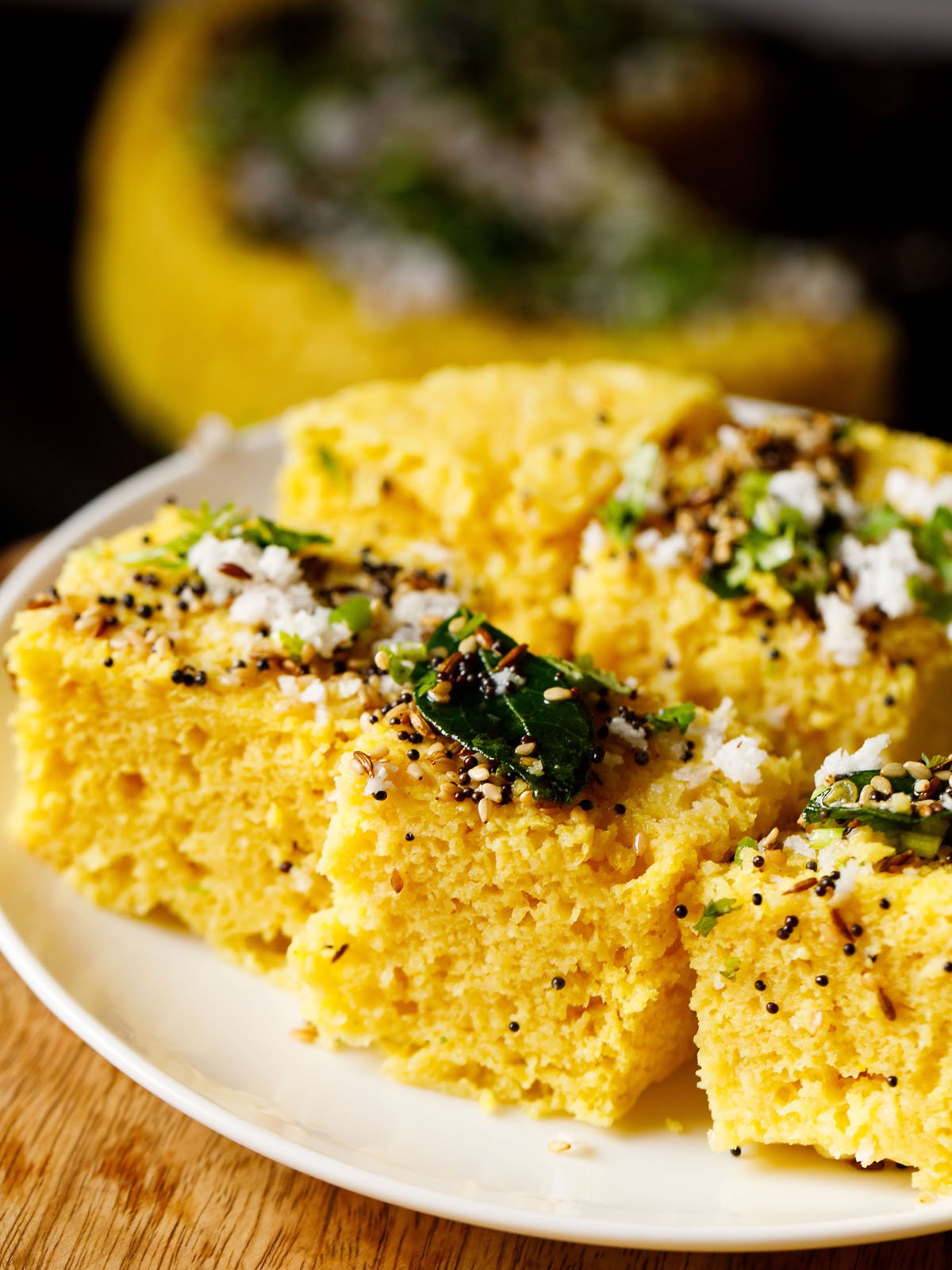
About Khaman Dhokla Recipe
Khaman, also known as Khaman Dhokla in other Indian states, is a popular delicacy from the Gujarati cuisine.
This popular light and spongy snack is made with a leavened batter of a spiced gram flour batter, that is later steamed in a pan. A tempering of spices and herbs is made which is then drizzled over this steamed cake.
This recipe makes a light, spongy dhokla and includes a hint of great savory flavor from a simple combination of gram flour (besan), spices, and herbs.
If you are wondering what is gram flour, it is simply is finely ground hulled black chickpeas. We also call it besan in Hindi.
Table of Contents
To leaven the batter instantly, there are a few ingredients you can use, that I have listed below. It is the reaction between the acidic lemon juice and the choice of leavening ingredient that aerates the batter, which helps in giving the Khaman its characteristic rise, softness and fluffiness.
Khaman is a healthy savory-sweet snack that happens to be vegan. Plus, it can be gluten-free too, if you skip semolina and asafoetida in the batter.
Khaman is also known as Yellow Dhokla as it has a yellow color or Besan Dhokla. It is also known as Instant Khaman.
I prepare Khaman Dhokla recipe with the steaming method either in an Instant pot or in a pan.
They’re perfect to enjoy for a hearty and satisfying breakfast or an afternoon or evening snack.
Dhokla vs Khaman
Khaman is popularly referred to as Khaman Dhokla but in actuality, a dhokla is made differently than khaman.
Dhokla is made with ground, fermented batter of rice and lentils like chana dal or urad dal. It is also called Vati Dal Dhokla in Gujarati.
While khaman recipe is made instantly with gram flour batter which is leavened by adding baking soda, citric acid or fruit salt. Khaman batter is not fermented unlike a dhokla batter.
The batter is leavened instantly using any of the leavening ingredients that you prefer. This leavened batter is then steamed in a greased pan like a steamed cake.
In the taste department, fermentation gives dhokla a really complex flavorsome taste, but a khaman also tastes equally great.
The color of dhokla can range from cream to light yellow or yellow but a khaman always has a bright yellow color.
Choice of Leavening Ingredients
To make soft and fluffy khaman dhokla you can choose between three leavening ingredients or a use a mix of two of them. Fruit salt, baking soda and citric acid are these ingredients and let us know more in detail about them.
1. Eno (Fruit Salt)
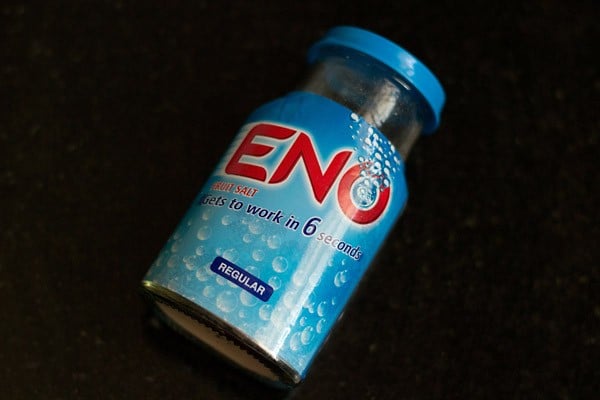
As a leavening agent, I use in this khaman recipe is fruit salt which results in a light and fluffy texture. Eno is a popular Indian brand of fruit salt that is used to relieve acidity and heartburn.
Fruit salt is composed of citric acid, sodium bicarbonate (baking soda), and sodium carbonate.
Sodium bicarbonate and sodium carbonate are effervescent ingredients that bubble and release carbon dioxide when added to water.
2. Baking Soda or Eno
To make khaman dhokla recipe, you can also use baking soda. But baking soda gives its soapy aroma if used in excess, so be careful not to add too much.
Eno gives you a perfect fluffy and soft khaman while the one made with baking soda is not that fluffy or spongy.
I personally prefer to use eno in khaman recipe as it gives the best results. I do not favor baking soda, as firstly we cannot stand the soapy aroma and secondly the texture is not that airy or spongy in comparison to the khaman dhokla recipe made with eno.
Use eno that is fresh and within its shelf period. If your eno is not fresh or active, the texture of khaman will be flat and dense. And please do not use flavored eno – the regular eno without any flavor works the best.
Both eno and baking soda react with turmeric powder and gives a red tinge or red spots in khaman dhokla. So add little turmeric powder or skip it completely.
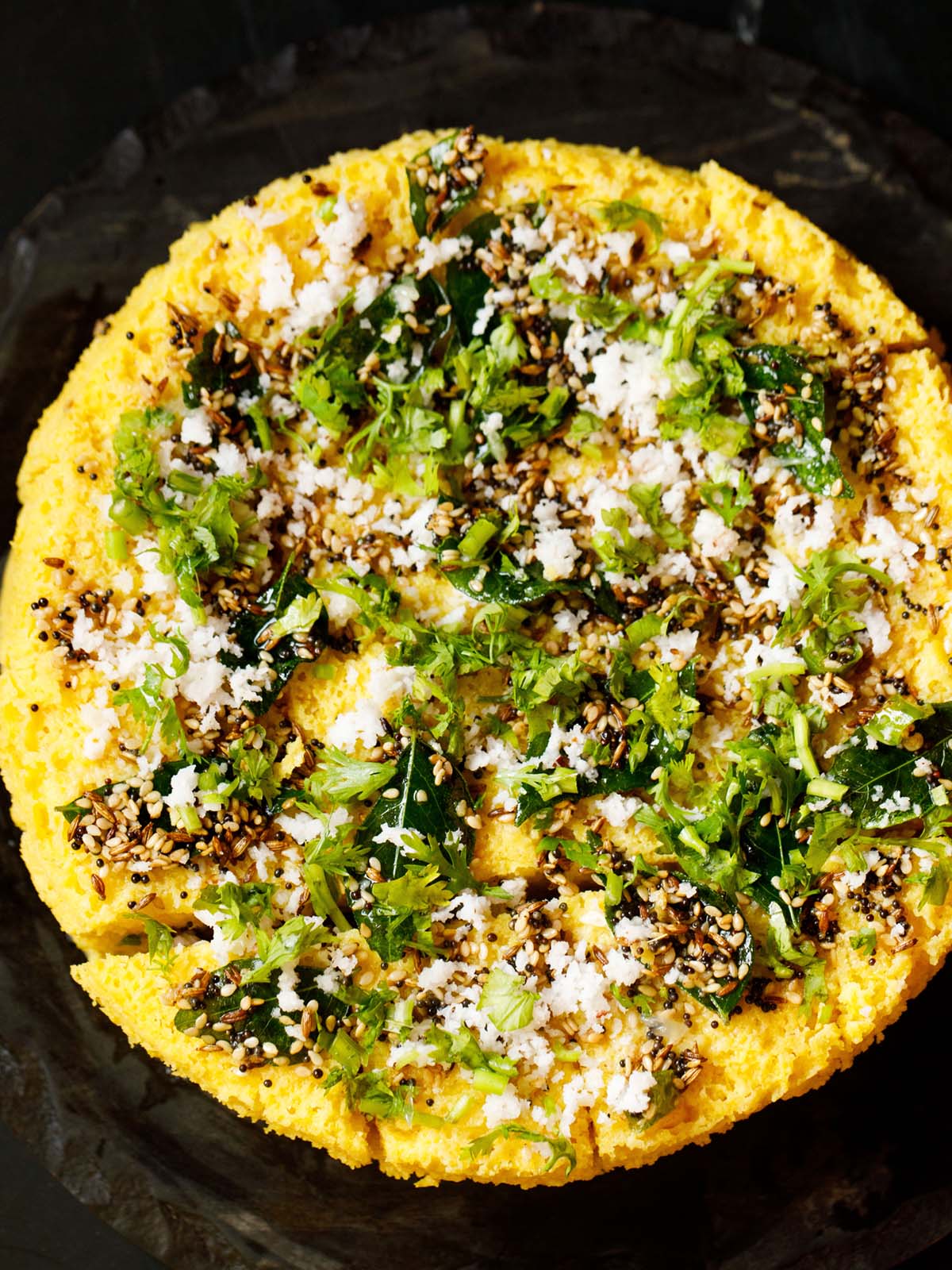
3. Lemon juice or Citric Acid
I have made khaman dhokla recipe both with lemon juice and citric acid. Citric acid gives a superb fluffy texture. Lemon juice also works great, but citric acid wins here. That said, use whatever is easily available to you.
To swap citric acid with lemon juice, use this standard proportion of:
1 tablespoon lemon juice = ¼ teaspoon citric acid (in the powdered form)
For citric acid, use a food-grade and pure citric acid. I also suggest including freshly squeezed lemon juice. Use a fresh lemon.
How to make Khaman Dhokla
Prep Pan
1. Grease a steamer pan with 2 to 3 teaspoons oil.
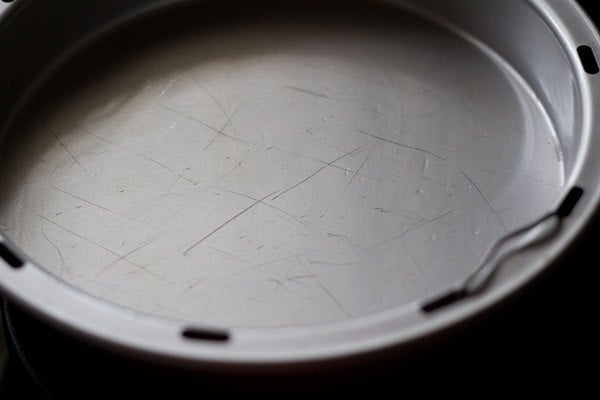
Make Batter
2. Take 1.5 cups gram flour (120 grams besan) in a mixing bowl or pan. Do use gram flour which has a fine texture.
Tip: You can make khaman with chickpea flour as well.
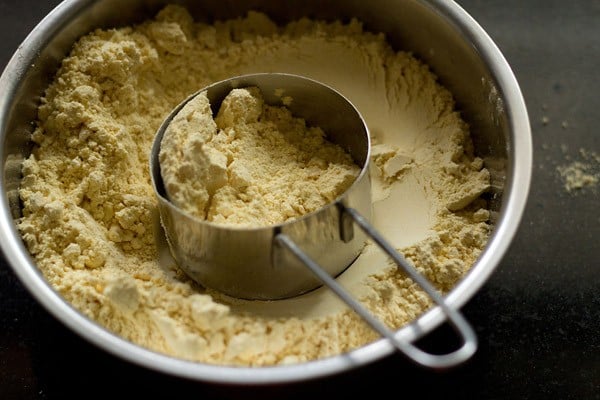
3. The add the following ingredients:
- 2 to 3 pinches of turmeric powder
- a generous pinch of asafoetida (skip to make a gluten-free version)
- 1.5 tablespoons lemon or lime juice or ⅓ to ½ teaspoon pure citric acid
- 1.5 teaspoons ginger paste (crush 1.5 inch ginger and 1.5 teaspoons green chilies in a mortar-pestle)
- 1.5 teaspoons green chili paste
- 1 tablespoon sugar or add according to taste
- 1 teaspoon salt or add as per taste
Tip: Avoid adding too much of turmeric powder as then the fruit salt or baking soda reacts with the turmeric powder and makes it red in color, thereby giving reddish dots, specks or tones in the khaman.
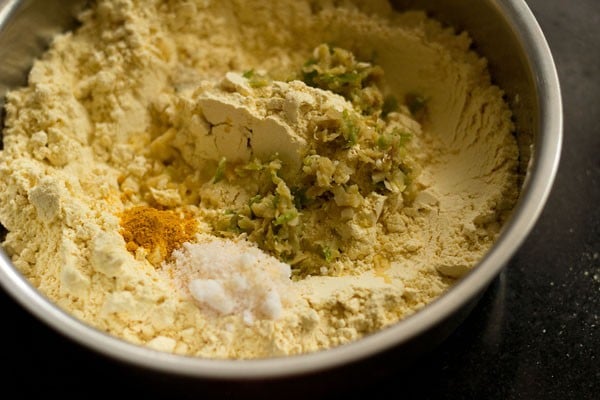
4. Add 1 cup water (or more or less as needed) and 1 tablespoon oil to make a thick yet smooth flowing batter.
The amount of water needed depends on the quality of flour, so start with 1 cup and add as required. Stir well to combine.
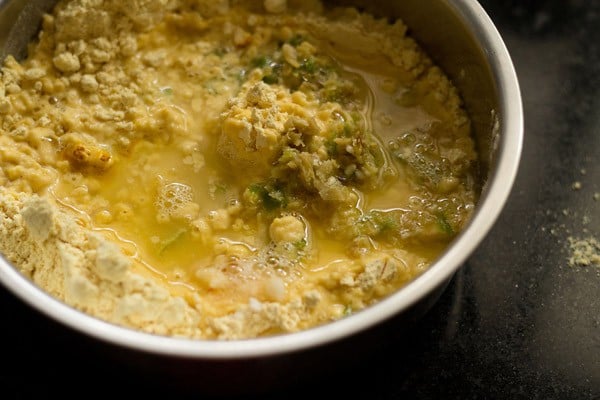
5. Then add 1 tablespoon rava (semolina). This is entirely optional but adds a good texture to the khaman. Skip rava or semolina for a gluten-free option.
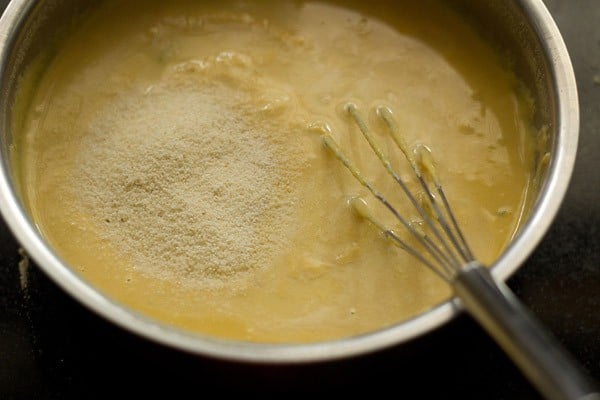
6. Stir with a whisk to create a smooth, thick batter without any lumps.
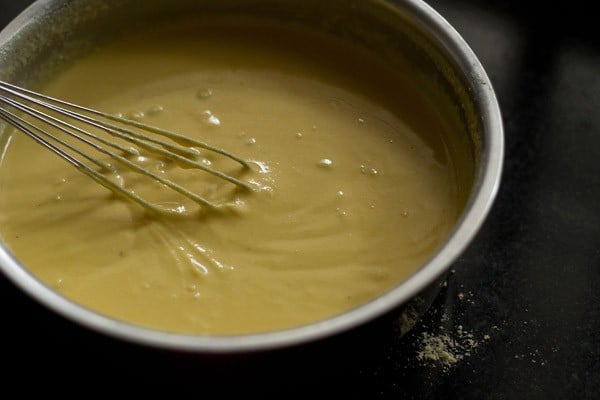
Batter Consistency
7. The batter should be thick yet flow easily off of the whisk. A quick tip is that if the batter becomes thin, then 1 to 2 tablespoons of gram flour.
Next bring 2 to 2.5 cups of water to a boil in a steamer pan or electric cooker or pressure cooker. The amount of water to be added depends on the size of the steamer or pressure cooker.
Note: To know more about the steaming in a pan, cooker and Instant Pot in detail, do read the tips section below.
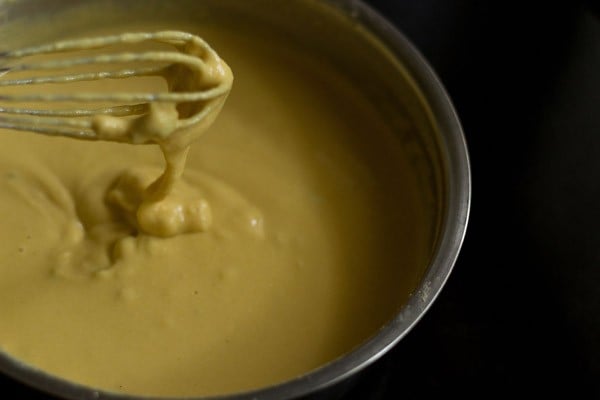
Leaven Batter
9. Next add 2 teaspoons Eno or fruit salt. 2 teaspoons of Eno makes the khaman soft and fluffy. But there is a slightly alkaline taste to Eno.
If you’re not a fan of this flavor then add only 1.5 teaspoons of Eno. If using baking soda as your leavening agent add ½ teaspoon to ¾ teaspoon.
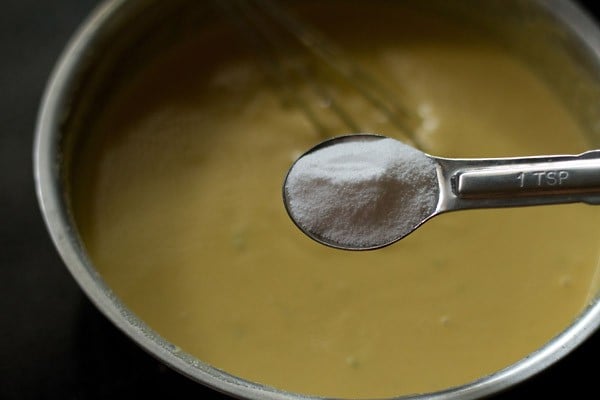
10. Stir and mix the eno with the batter briskly and quickly.
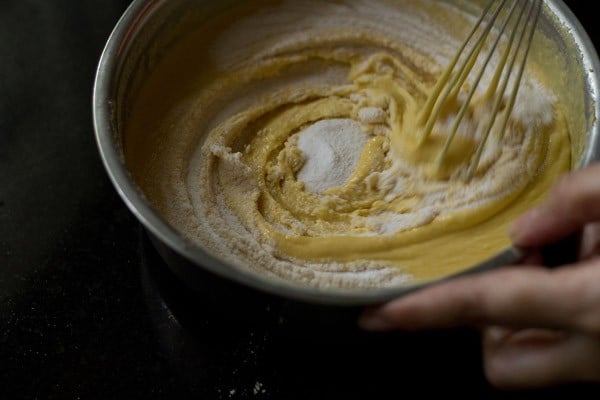
11. The fruit salt should be mixed evenly with the batter. Or else you get uneven texture in the khaman.
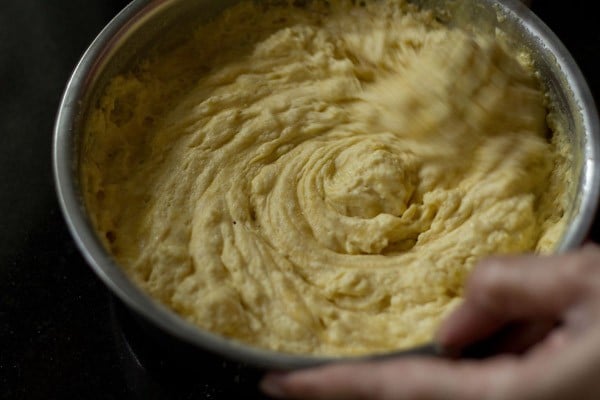
12. The eno will make the batter become frothy, so you need to work quickly to whisk it in thoroughly.
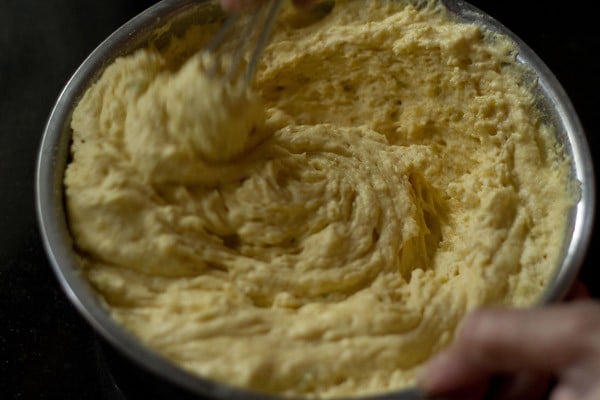
12. Pour the prepared batter into the greased pan.
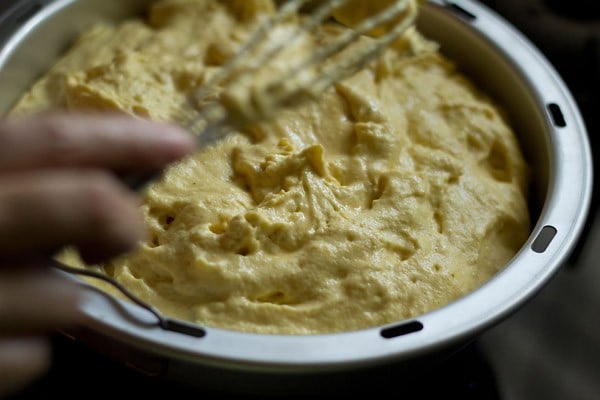
13. Gently shake so that the batter evens out in the pan. Below is a picture of the batter ready to be steamed.
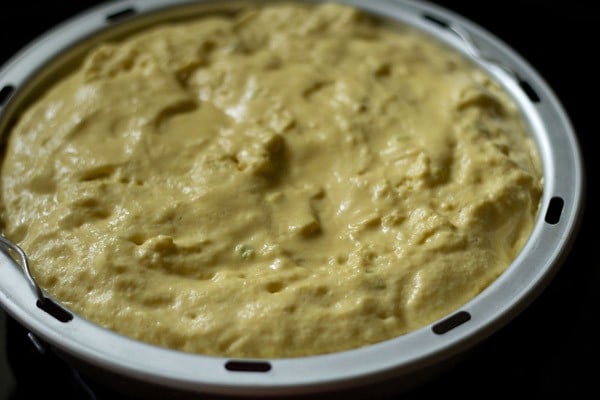
Steam
1. Place the pan in a steamer or electric rice cooker or pressure cooker. The water should already be boiling or hot when you place the pan with the khaman batter.
When using a pressure cooker, remove the vent weight/whistle from the lid and cover the cooker tightly with its lid.
Note: I have listed the detailed directions of steaming in a pan, pressure cooker and Instant pot in the tips sections below.
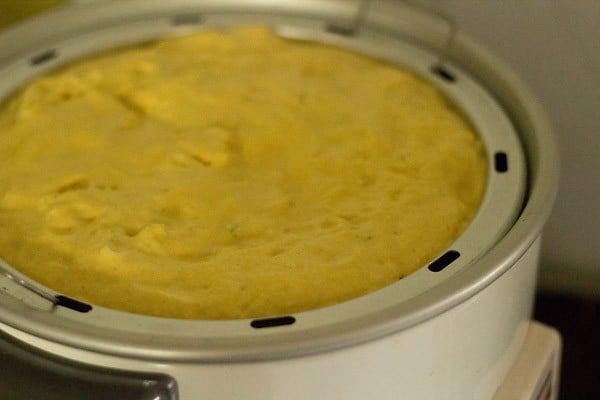
2. Steam for 15 to 20 minutes in an electric rice cooker. If using a pan or pressure cooker or Instant Pot, steam for 12 to 15 minutes on a medium to medium-high heat.
In the below photo the khaman is cooked for 17 minutes using an electric rice cooker.
You can begin working on the spice and herb solution for tempering the khaman while it cooks. Continue reading for the instructions.
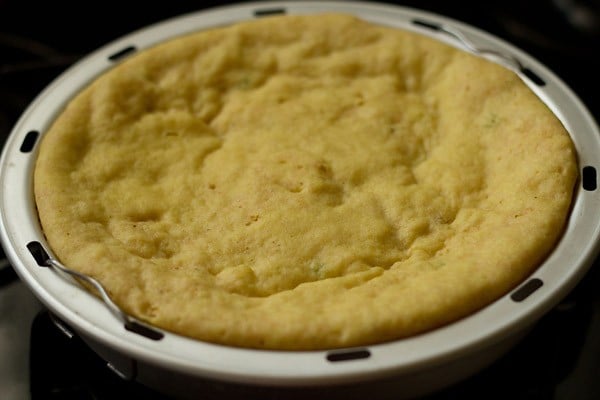
3. To check the doneness, insert a toothpick. It should come out clean if the khaman is done. If the toothpick has the batter on it, then you need to steam for another minutes or so.
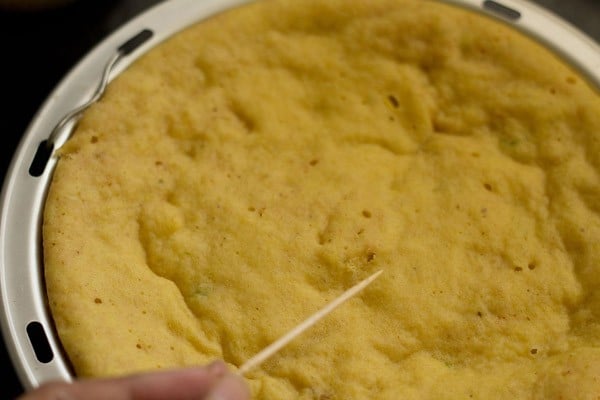
4. Let the khaman become warm or cool completely. Gently slide a butter knife along the edges to release the khaman from the pan. Place a plate or tray on top of the pan.
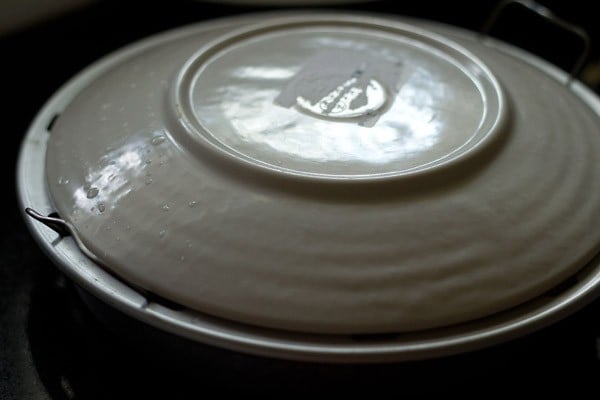
5. Then quickly invert the pan.
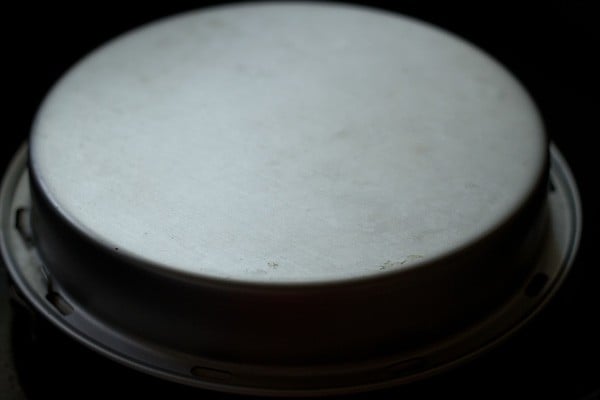
6. If greased well, the khaman will easily slide out onto the plate.
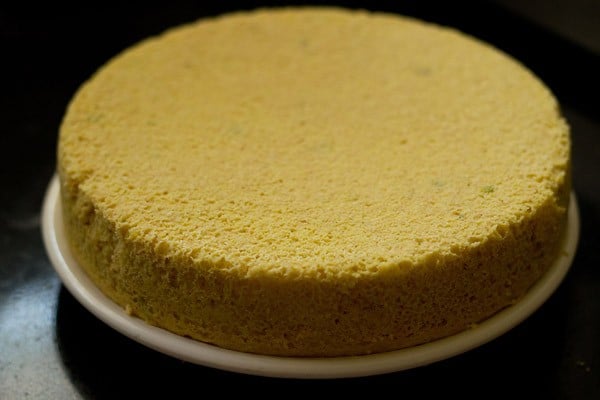
7. Use a sharp knife to slice the khaman in squares and set aside until ready to temper.
Since I used a concave plate, the khaman settled down in the center. This won’t happen if you use a flat plate.
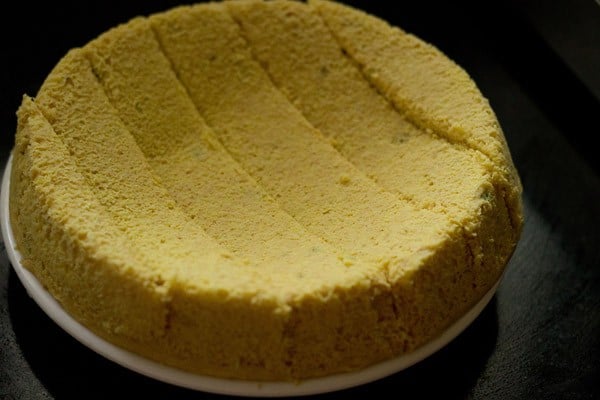
Temper Khaman Dhokla
1. Tempering is essential to infuse the khaman with flavor and add moisture to the gram flour sponge. To make the temper, first heat 2 tablespoons of oil in a small pan on the stove. Use peanut oil or any neutral-tasting oil.
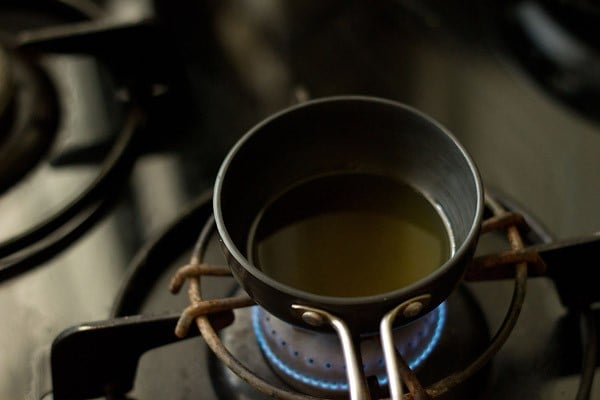
2. Add 1 teaspoon of mustard seeds and allow them to crackle.
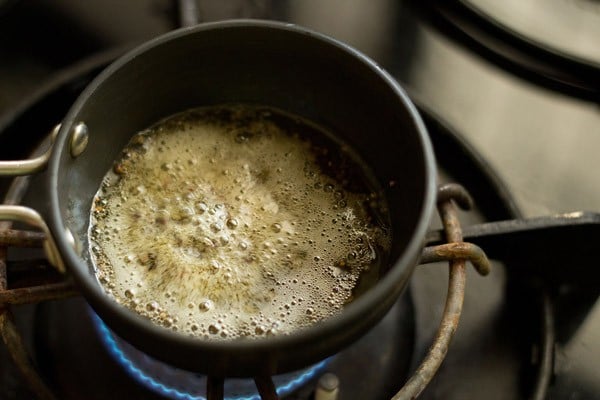
3. When the mustard seeds are crackling, add 10 to 12 curry leaves, and, if you like, 1 teaspoon of cumin seeds and 1 teaspoon of chopped green chili.
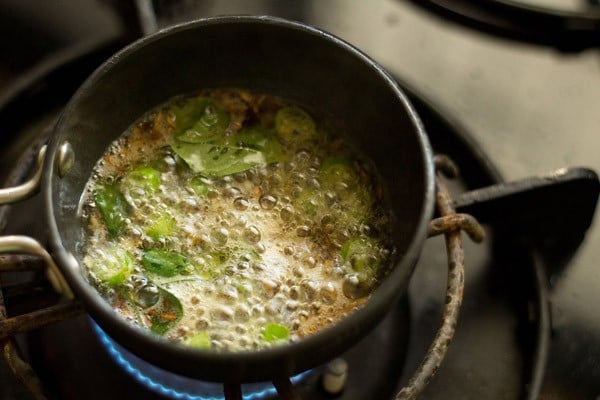
4. Stir and then add 2 teaspoons white sesame seeds.
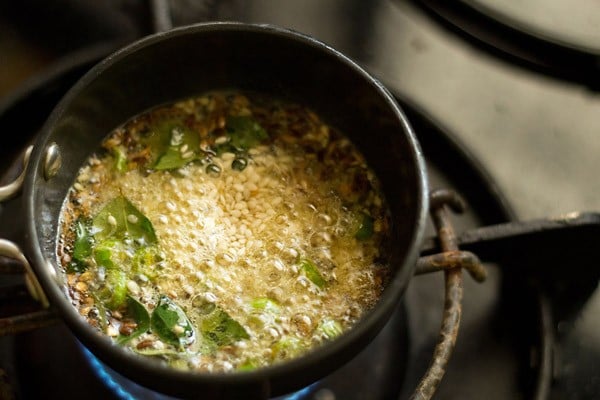
5. Fry the sesame seeds for some seconds. But don’t brown them or they’ll become bitter.
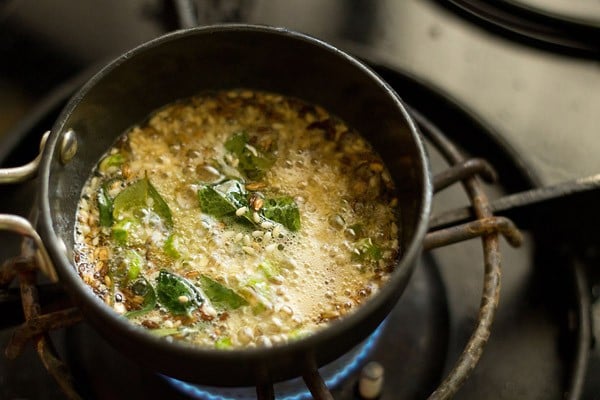
6. Next carefully add ⅓ cup of water. You can switch off the heat when adding water.
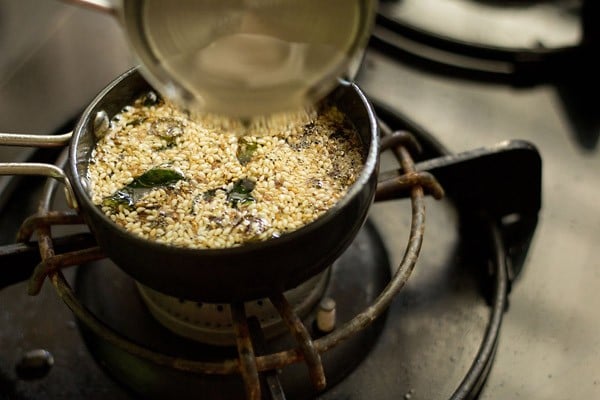
7. Next add 2 teaspoons of sugar.
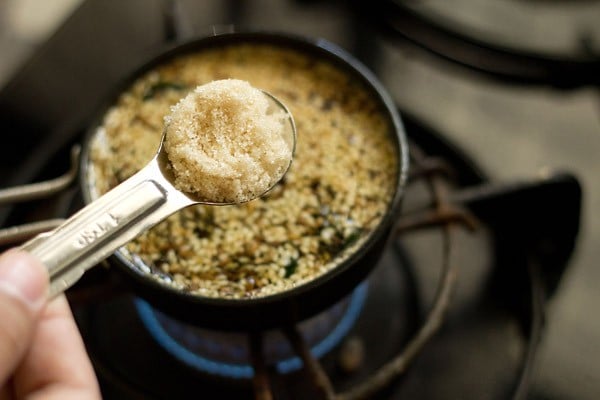
8. Stir and allow the tempering mixture to come to a boil. Make sure that the sugar is dissolved.
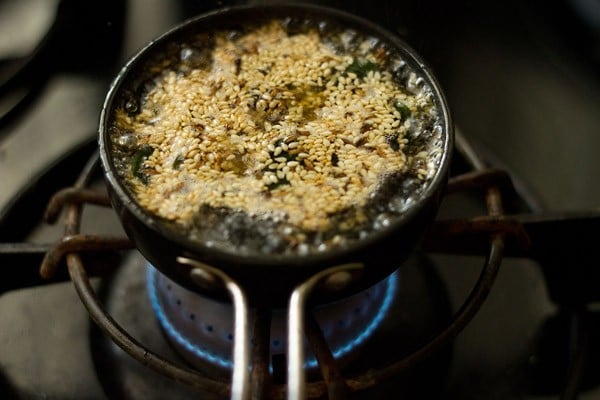
9. Remove from the heat and immediately pour this tempering mixture evenly on the khaman dhokla so that it seeps through the sliced edges.
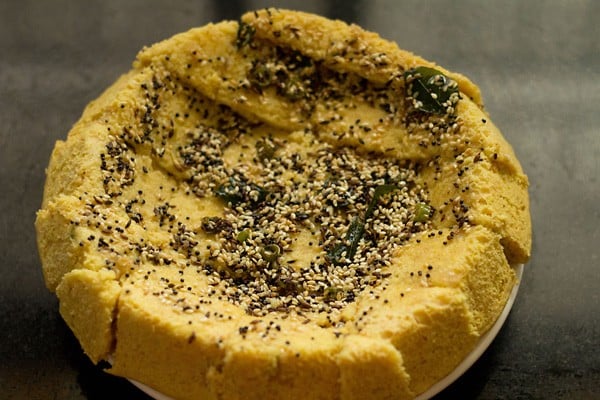
10. Garnish with 2 to 3 tablespoons of chopped coriander leaves and 2 to 3 tablespoons grated coconut, if you like.
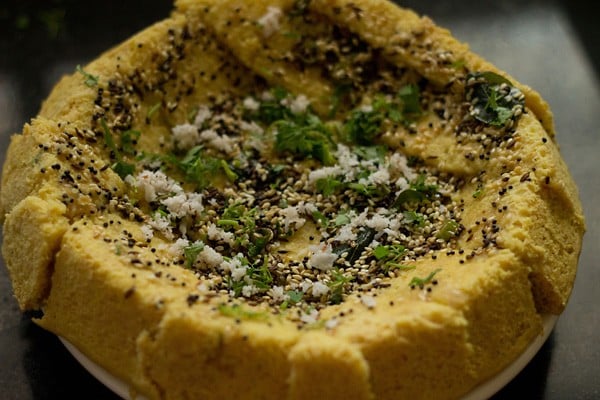
Serving Suggestions
Serve the Khaman Dhokla straight away or you can store it in an airtight box and serve later after an hour. If enjoying khaman later after several hours, then don’t add coconut until ready to eat.
You can also refrigerate them, and then when ready to serve just sprinkle some water and heat in a microwave for a few seconds until just warmed.
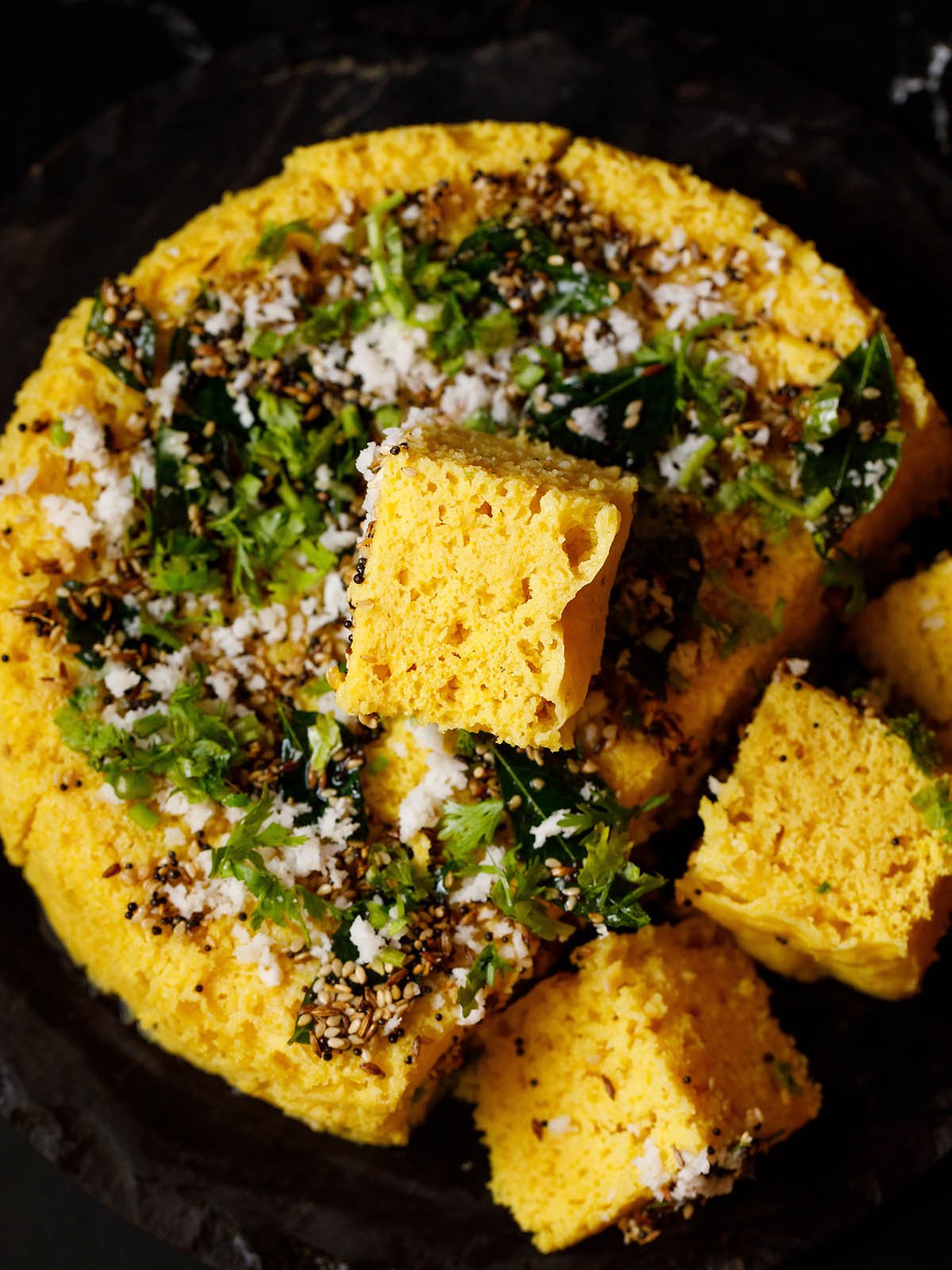
What to eat with Khaman
The sweet, savory, fluffy cakes pair great with our usual assortment of Indian chutneys like Papaya Chutney, Mint Chutney, or even Coriander Chutney.
We also like to pair it with Tamarind Chutney. You can also serve it as a healthy snack with your evening chai.
Storing Suggestions
If you plan to serve khaman after a few hours or next day, then I do not recommend to add coconut or coriander. Simply pour the tempering.
Refrigerate the khaman in a covered container. While serving you can warm with a sprinkling of water in a microwave or an oven.
If using the instant pot to warm, then steam for 1 to 2 minutes. While serving add the coconut and coriander leaves.
Expert Tips
Batter Consistency: The batter consistency has to be flowing but thick to medium-thick. 1 cup water with 1.5 cups of gram flour, always gives me perfect results, but you can add a few tablespoons of water if your batter looks very thick. A super thick batter will make the khaman hard and dense. A thin batter won’t hold shape and will become a mess.
Leavening Ingredient: Feel free to use any of the leavening ingredient. I usually make Khaman Dhokla recipe with eno. Simply ensure that your leavening ingredient is fresh and within its shelf period.
Flavor Adjustments: Khaman always has a sweet and tangy flavor. If you do not prefer the sweetness, I would suggest reducing the sugar but do not omit it entirely. The sweetness balances the tangy taste. You could though add the spices like green chillies and ginger according to your preferences.
Steaming: In a standard pan of 7 to 8 inches, it will take about 12 to 15 minutes for the batter to steam in a pan. Avoid overdoing the steaming as this may result in your Khaman becoming dry and crumbly.
Three Steaming Techniques
You can steam khaman in a pan, stove-top pressure cooker, or in an Instant Pot. I list below in detail on steaming khaman in each.
1: Steaming in a pan or pot
1. Place a small trivet in a large steaming pan that has enough room to keep the pan with the batter. Pour 2 to 2.5 cups of water. Bring it to a boil.
2. Place the batter pan as soon you mix with eno. Cover with a lid (not tight fitting) but one that has a vent or will allow some steam to pass through.
3. Steam for 12 to 15 minutes on medium-high heat. The deeper the pan is in touch with the boiling water, the faster the steaming is. If it is away from the boiling water, the steaming will take a bit more time.
2: Steaming in a stove-top pressure cooker
1. Place the trivet in a pressure cooker. Add 2 to 2.5 cups water. Heat the water until it begins boiling. Secure the pan tightly between tongs and carefully place it on the trivet.
2. Remove the whistle (vent weight) from the lid and seal the lid tightly. Steam for 12 to 15 minutes on medium to medium-high heat.
3: Instant Pot Steaming
1. Pour 2 to 2.5 cups of water in the steel insert of your IP. Place a trivet (not short or long, but kind of in between).
2. Use the sauté function and let the water get heated up and start simmering.
3. Using tongs or with oven mitts carefully place the pan with the khaman batter on the trivet. Do not cover with any lid.
4. Cover and seal IP with its lid and keep the vent position to steam release. Press the steam button and steam on high pressure for 12 to 15 minutes.
5. Keep a check of the time using a clock or watch as Instant pot does will not beep after the elapsed time and will continue to steam. Let all the pressure release and the valve fall down. Then open the lid carefully.
FAQs
The sponginess and light texture in the instant khaman dhokla recipe comes from reaction of eno with lemon juice or citric acid releasing carbon dioxide.
This reaction creates a fizzy bubbly mixture that helps the batter to rise and leaven thereby making it fluffy and spongy when steamed. So if you use less leavening agents (eno, baking soda) or if they are not fresh or active, your khaman won’t be spongy.
Turmeric powder reacts with baking soda or eno to give orange or red colored spots or patches in khaman dhokla. This makes your khaman turn orange or red. This can be avoided by adding less turmeric powder to the batter.
It can be eaten warm or at room temperature.
Adding too much of leavening ingredients like baking soda can make your dhokla bitter.
More Popular Gujarati Snacks!
Gujarati Food Recipes
Snacks Recipes
Gujarati Food Recipes
Gujarati Food Recipes
Please be sure to rate the recipe in the recipe card or leave a comment below if you have made it. For more vegetarian inspirations, Sign Up for my emails or follow me on Instagram, Youtube, Facebook, Pinterest or Twitter.
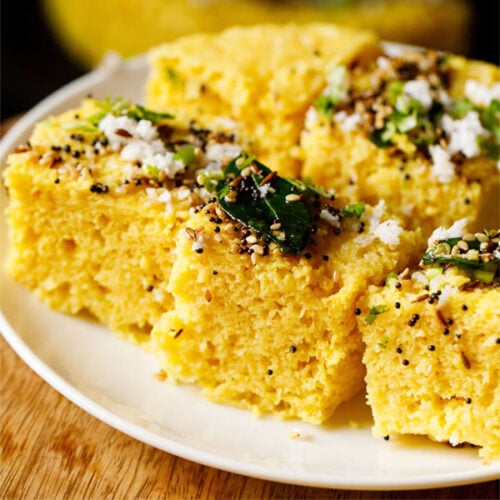
Khaman Dhokla Recipe (Instant Gujarati Khaman)
Ingredients
For khaman batter
- 1.5 cups gram flour (besan), 180 grams
- 1 tablespoon rava (semolina) – optional
- 1 tablespoon sugar
- 1.5 inches ginger – crushed to a fine paste in a mortar-pestle
- 1.5 teaspoons green chillies – chopped and then crushed to a fine paste in a mortar-pestle
- 2 to 3 pinches turmeric powder (ground turmeric)
- 1 to 2 pinch asafoetida (hing)
- 1 tablespoon oil – any neutral oil or peanut oil
- 1.5 to 2 teaspoons eno (fruit salt) or ½ to ¾ teaspoon baking soda
- 1 teaspoon salt or add as required
- 1.5 tablespoon lemon juice or ⅓ to ½ teaspoon pure food grade citric acid
- 1 cup water or add as required
For tempering khaman dhokla
- 2 tablespoons oil – any neutral oil or peanut oil
- ⅓ cup water
- 1 teaspoon mustard seeds
- 1 teaspoon cumin seeds – optional
- 2 teaspoons white sesame seeds
- 1 sprig curry leaves – about 10 to 12 curry leaves
- 1 teaspoon green chilies – chopped, optional
- 2 teaspoons sugar or add according to taste
For garnish
- 2 to 3 tablespoons coriander leaves – chopped (cilantro)
- 2 to 3 tablespoons coconut – grated and fresh, optional
Instructions
Making khaman batter
- Grease a steamer pan with 2 to 3 teaspoons of oil.
- Take besan or gram flour in a mixing bowl or pan.
- Add turmeric powder, asafoetida, lemon juice, ginger paste, green chilies paste, sugar, oil and salt.
- Add 1 cup water or as required to make thick yet flowing water. The amount of water required depends on the quality of flour, so add as required.
- Stir and then add the rava or sooji (semolina).
- Stir to a smooth thick batter without any lumps.
- The batter should be thick yet flowing. A quick tip is that if the batter become thin, then add 1 to 2 tablespoons besan.
- Bring to a boil 2 to 2.5 cups of water in a steamer pan or electric cooker or a stove-top pressure cooker.
- The amount of water to be added depends on the size of the steamer or pressure cooker.
- Now add the eno or fruit salt to the batter.
- Stir briskly and quickly. The fruit salt should be mixed evenly with the batter. Or else you get uneven texture in the khaman.
- The batter would froth and become bubbly, so you have to be quick.
- Pour the batter in the greased pan.
Steaming khaman dhokla
- Place the pan in a steamer or electric rice cooker or pressure cooker. The water should already be boiling or hot when you place the pan with the batter. When using pressure cooker, remove the vent weight/whistle from the lid and cover the cooker tightly with its lid.
- Steam for 15 to 20 minutes in an electric cooker. If using a pan or pressure cooker, steam for 12 to 15 minutes on a medium to high heat.
- To check the doneness, insert a toothpick and if it comes out clean, the khaman is done. If the toothpick has the batter on it, then you need to steam for some more time.
- When the khaman become lukewarm or cool, then with a butter knife gently slid along the edges. Keep a plate or tray on top of the pan.
- Invert the pan. If greased well, the khaman will easily get inverted on the plate. Slice and keep aside.
Tempering
- In a small pan, heat oil.
- Add mustard seeds and let them to crackle.
- When the mustard seeds are crackling, add the cumin seeds (optional), curry leaves and chopped green chilies (optional).
- Stir and then add sesame seeds.
- Fry the sesame seeds for some seconds but do not brown them.
- Then add water. Be careful while adding water as the mixture sizzles. You can switch off the heat when adding water.
- Add sugar. Stir and allow the tempering mixture to come to a boil. Make sure that the sugar has dissolved in the water.
- Then pour this tempering mixture evenly on the steamed and sliced khaman.
- Garnish with chopped coriander seeds and grated coconut.
- Serve khaman dhokla straight away or you can store them in an air tight box and then serve later after some minutes or an hour.
- If serving khaman after many hours, then do not garnish with coconut and coriander leaves.
Serving Suggestions
- The sweet, savory, fluffy cakes pair great with any spicy or sweet Indian chutney.
- You can also serve it with your evening chai.
Storing Suggestions
- If you plan to serve khaman after a few hours or next day, then I do not recommend to add coconut or coriander leaves. Simply pour the tempering.
- Refrigerate the khaman in a covered container. While serving you can warm with a sprinkling of water in a microwave or an oven.
- If using the instant pot to warm, then steam for 1 to 2 minutes. While serving add the coconut and coriander leaves.
Video
Notes
Ingredient Notes
- Eno: Use the regular plain eno without any flavors.
- Gluten-free: For making khaman gluten free, skip the asafoetida and semolina.
- Baking soda or Eno: The ingredient which we use to leaven the khaman batter is fruit salt. Eno is a popular Indian brand of fruit salt. You can also use baking soda. However baking soda gives the soapy aroma if used in excess. Again both eno and baking soda react with turmeric powder and gives a red tinge or red spots in khaman. So add little turmeric powder or skip it completely.
Recipe Notes
1. Batter consistency The consistency of the batter is flowing but thick to medium-thick. 1 cup water with 1.5 cups of gram flour, always gives me perfect results, but you can add a few tablespoons of water if your batter looks very thick. A super thick batter will make the khaman hard and dense. A thin batter won’t hold shape and will become a mess. 2. Steaming Methods You can steam khaman in a pan, stove-top pressure cooker, or in an Instant Pot. I list below in detail on steaming khaman in each. a) Steaming in a pan or pot- Place a small trivet in a large steaming pan that has enough room to keep the pan with the batter. Pour 2 to 2.5 cups of water. Bring it to a boil.
- Place the batter pan as soon you mix with eno. Cover with a lid (not tight fitting) but one that has a vent or will allow some steam to pass through.
- Steam for 12 to 15 minutes on medium-high heat. The deeper the pan is in touch with the boiling water, the faster the steaming is. If it is away from the boiling water, the steaming will take a bit more time.
- Place the trivet in a pressure cooker. Add 2 to 2.5 cups water. Heat the water until it begins boiling. Secure the pan tightly between tongs and carefully place it on the trivet.
- Remove the whistle (vent weight) from the lid and seal the lid tightly. Steam for 12 to 15 minutes on medium to medium-high heat.
- Pour 2 to 2.5 cups of water in the steel insert of your IP. Place a trivet (not short or long, but kind of in between).
- Use the sauté function and let the water get heated up and start simmering.
- Using tongs or with oven mitts carefully place the prepared pan with the khaman batter on the trivet. Do not cover with any lid.
- Cover and seal IP with its lid and keep the vent position to steam release. Press the steam button and steam on high pressure for 12 to 15 minutes.
- Keep a check of the time using a clock or watch as Instant pot does will not beep after the elapsed time and will continue to steam. Let all the pressure release and the valve fall down. Then open the lid carefully.
Nutrition Info (Approximate Values)
This Khaman Dhokla recipe from the archives was first published on August 2012. It has been updated and republished on June 2024.
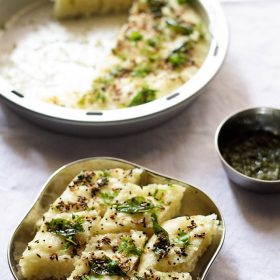
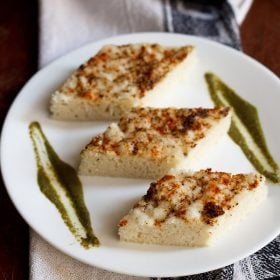
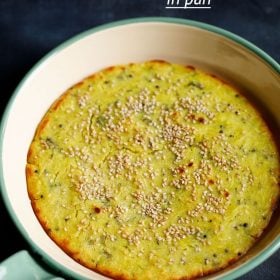
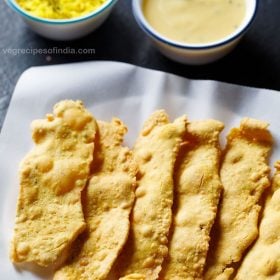
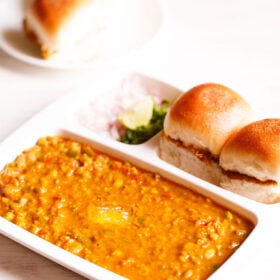
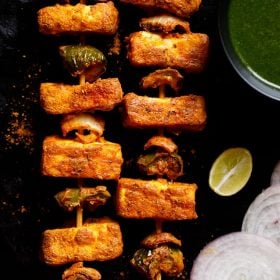
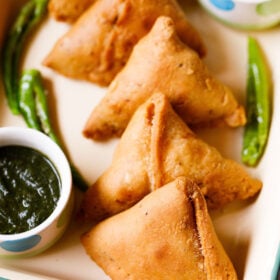
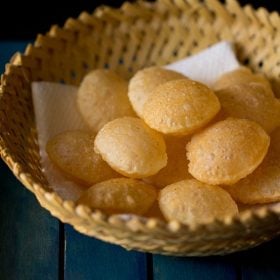








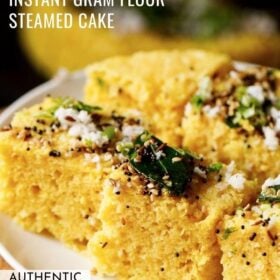
i HAVE to try this…. teh steamed version definitely has its charm.. but i think i will go for teh microwave version first.. my hubby is not a fan of dhokla..i hope i can convince him ..planning a weekend breakfast …
noting down ur recipe.. i thinki have all ingredients except fruit salt..
will let u know..i hope i can make it tom… seeing ur pics i am really really tempted…
i seriously wish i was ur neighbour or friend in pune…:).. honestly…. saying this from teh bottom of my heart:)
thanks a lot renu. if we were neighbors both of us would have a good time. add baking soda instead of the fruit salt. just add very little of turmeric powder or avoid it as the dhoklas turn red due to the reaction between baking soda and turmeric powder.
hi, can tell me the measurement of one cup in gms or ltrs
i think you are asking for 1 cup of besan. 1 cup of gram flour is 92 grams.
i want to ask …in microwave we can cook dokla on simple mood as it is or wecan use steam option ?
mansi, i don’t have steam option in my microwave oven, so not sure about it. i used the microwave mode.
hii nice recipe 🙂
I have a quick question…..can we add cook soda instead of eno salt
you can add cooking soda instead of eno. but it may make the dhokla red or give red patches due to reaction between the turmeric and soda. you can just add a pinch of turmeric in this case. 1/2 tsp soda would be fine.
I treid most of you dishes, they are all excellent, thasnk for sharing. but this dish you said 1 tsp oil and you have almost used 1 cup oil. Thks
thanks loreen for trying the recipes. regarding this recipe, where i have used 1 cup oil? it 1 tbsp oil for the tempering which is mixed with 1/2 cup water.
Hi Dassana, Thank you for sharing such a lovely recipe. I shared my experiences with it here: http://tastespace.wordpress.com/2013/06/01/steamed-indian-chickpea-cakes-microwave-khaman-dhokla/
thanks and will check janet.
Hello,
Can I substitute Baking Powder for the Eno Fruit Salt? Eno Fruit Salt is no recommended for diabetics.
Many Thanks,
Greg
hi greg. i would suggest you to add baking soda instead of baking powder. baking powder won’t be able to leaven the dhokla batter effectively. if using baking soda, then don’t add turmeric as baking soda reacts with turmeric and gives a reddish color. the dhokla will will have reddish tones in it.
Thank you Dassana!
I LOVE your website! Most informative and very helpful. I’m a Gluten-free, Sugar-free Vegan and felt as tough I had very few options. India spices have opened a new world in cooking for me. My overall health has improved immensely, since I deleted all gluten and sugar from my diet (I use Stevia and/or “Just Like Sugar” instead of cane sugar). I mostly use chickpea Flour and coconut oil for cooking. Fresh fruits ,vegetables and beans. My goal is not focused on a certain body weight, but to achieve optimum health through my daily diet. In other words, good nutrition is key!
Namaste,
Greg
welcome greg. good to know that you are on your way to wholesome food and healthy diet. indian food has a plenty of healthy options as far as everyday meals are concerned. also barring some milk based sweets, all indian food can be veganised easily. in fact the south indian food is vegan naturally as only coconut or coconut milk is used to make them. even desserts and sweets are made from coconut milk.
just a note on asafoetida. someday a visitor left a comment that asafoetida is not gluten free. i did some research. if using asafoetida, then use the ones which are available in small rocks or lumps. don’t use the powdered form as wheat is added in these, unless the package mentions otherwise. and yes indian spices can really warm up and meal and make it delcious as well.
I love love love your site! And this is my favorite..Thank you for posting a Dhokla recipe I can actually make
thanks a lot aneeta.
I like new recipes in english and gujarati.
Thank you very much
Hi
I suppose the bottled hing normally called as compounded asfoetida has wheat flour mixed with it an hence not gluten free but the khada hing is gluten free
yes, even i think so. but then always better to check the ingredients list and buy asafoetida.
pl let me know the temperature at what oven be kept and also bake,roast or grill in every veg. recipe as it may helpful for alone person not knowing fundamentals of microwave also.
i will be doing a separate post on the this.
I’ve never heard of fruit salt before and didn’t know where to get it, so I used baking soda and it turned out great!
thats great jessica. even baking soda works well instead of fruit salt.
Hi Dassana ….I have tried making dhokla at home 3-4 times and it has always ended in a disaster. :(but today I tried making dhokla again with your microwave option receipe and I am amazed to see that it came out perfecccctttt!!!wow ..I am thrilled …thanks so much for your receipe ….I have a request …can you also come up with some low cal /diet food recipes …that will be great!!
Cheers…
thats nice to know priya. cooking in microwave can be a disaster at times. except for the fried food recipes and rich recipes on the blog, most of the recipes i post are low cal…. i will categorize the existing recipes where not much oil, sugar or butter or milk products is used as low cal. will give you the link too after categorizations so that you can view all the recipes at one go… will also post more such recipes in the future.
JGD Mam,
I cooked dhokla today…it seems as ur’s n taste also good… but it’s not as soft as some bakery’s … plz tell y… i added 1/4 cup suji also….
Thx 🙂
dear mehak, suji absorbs more water than besan, so the consistency of the batter has to be adjusted accordingly. you would need to add more water in this case. also while microwaving, even if it is microwaved a little more, than the dhokla can become hard. this has happened with me too once. the dhokla became a little dense. it could be that the dhokla did not become soft due to these reasons.
wow nice observation…. thx Mam 🙂
I’m sorry, but asafetida or hing is NOT gluten free.
thanks harpreet for letting me know about asafoetida not being gluten free. i was not aware of this. i did check the brand i use and it does not mention wheat or wheat product anywhere. so i assume that the brand i use is gluten free.
i also did some research on the web and came to know that in united states wheat is added to asafoetida. i did not know about this too. also there is a brand known as frontier brand which has asafoetida totally gluten free. i think people who suffer from gluten intolerance would be much more aware than me and would skip asafoetida in this recipe as well in their other food if it calls for it.
anyways thanks for this info. this is totally new to me. next time when i buy hing, i will check the details as well as update it in this post.